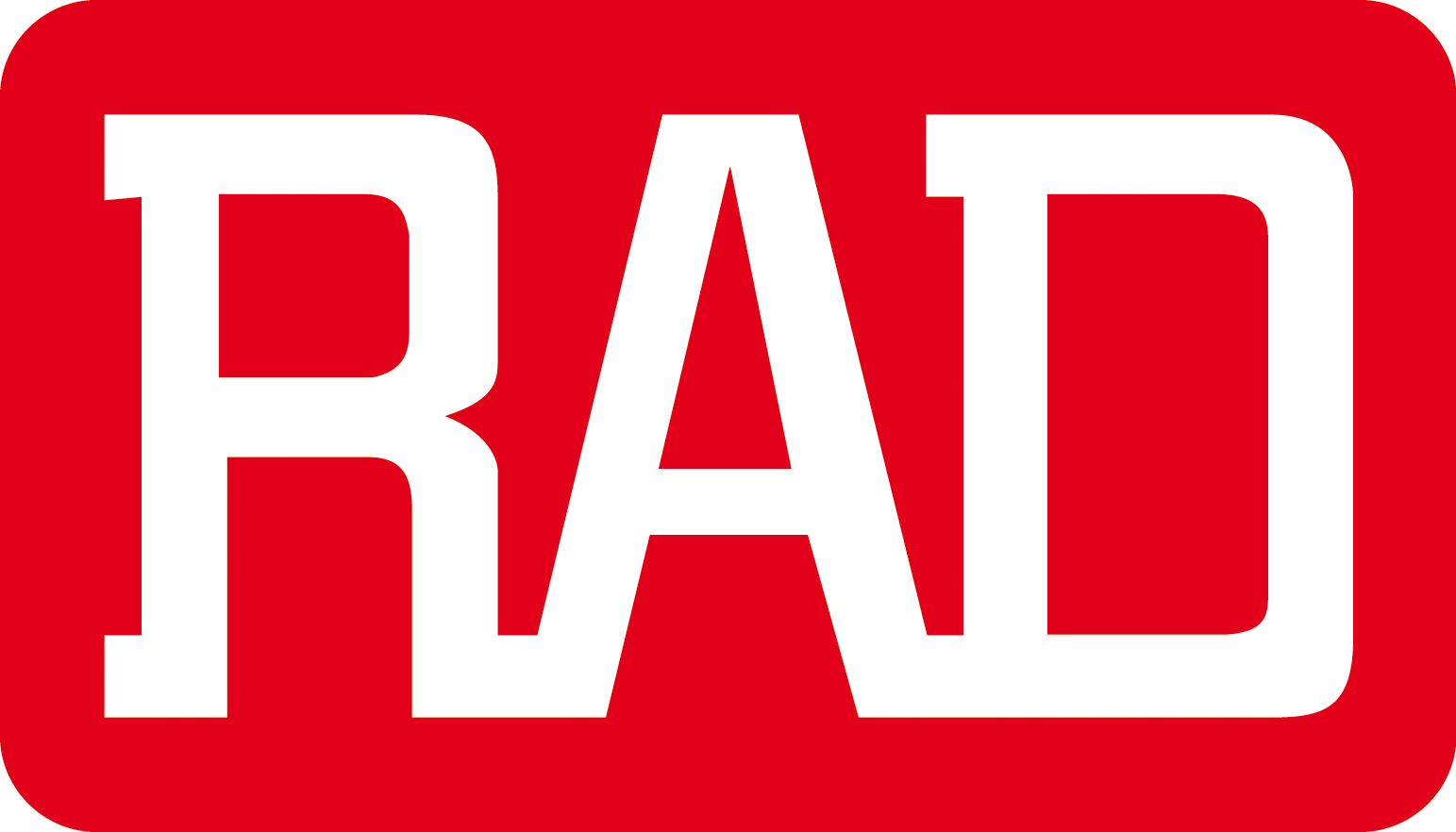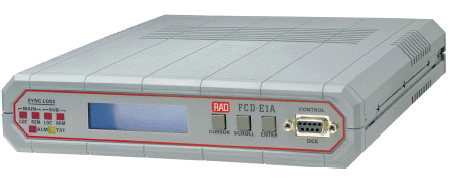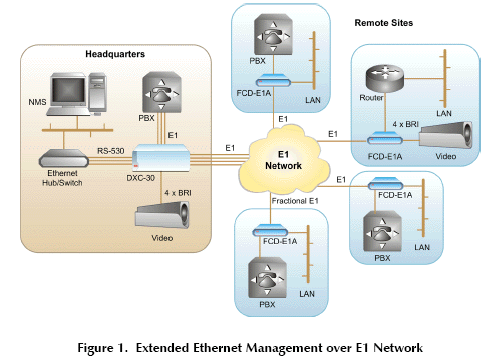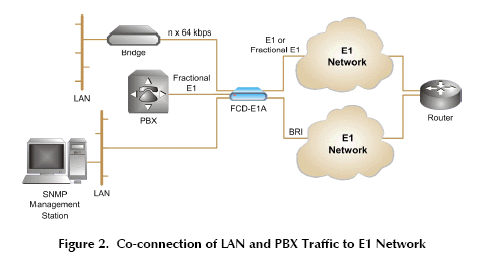




FCD-E1A access unit for E1 or fractional E1 service
FCD-E1A is an access unit for E1 or fractional E1 services. It can be used as a rate and interface converter, or as an integrating
multiplexer for E1 and fractional E1 services (see Figures 1 and 2). FCD-E1A operates opposite RAD's modular DXC multiservice
access nodes or other vendors’ E1 equipment, for multilink star applications such as SDH network access. DXC and FCD-E1A units
operate together under centralized SNMP network management (see Figure 3). The RAD FCD-E1A can be ordered with either a
standard electric (G.703) or a fiber optic E1 main link. These options are also available with an optional sub-E1 drop-and-insert port.
The FCD-E1A can be ordered with either one or two data ports. Alternatively, an Ethernet bridge / router port is available instead of a second data port.
FCD-E1A BASIC UNIT
The basic FCD-E1A includes a power supply, one E1 main link, and one data port. The electrical E1 interface is compatible with
virtually all carrier-provided E1 services and meets ITU recommendations G.703, G.704, G.706, and G.732. The
FCD-E1A supports both 2 and 16 frames per multiframe, with or without CRC-4. Line coding is HDB3. The integral LTU (soft-configurable) ensures a range
of up to 2 km (1.2 miles). FCD-E1A can be ordered with a fiber optic link to eliminate the need for an external fiber optic modem. The
fiber optic link provides a secure link in hazardous or hostile environments. It complies with ITU standards G.921 and G.956.
FCD-E1A available fiber optic interfaces:
850 nm laser transmitter for multimode fiber of up to 5 km (3 miles)
1310 nm laser transmitter for single mode fiber of up to 62 km (38 miles)
1550 nm laser transmitter for single mode fiber for extended range of up to 100 km (62 miles).

Timeslot assignment is programmable, allowing data from each data or sub-E1 port to be placed automatically into
consecutive timeslots. Alternatively, the user can assign timeslots manually. Multiple clock source selection ensures maximum
flexibility for supporting different applications. The E1 main link may derive its timing from the recovered receive clock, from an internal
oscillator, from one of the data ports, or from the sub-E1 port. ISDN dial backup ensures the continuity of data services. Bypassing
the sub-E1 port to the G.703 main link (electric only) ensures uninterrupted service to the sub-E1 port and provides immunity from
hardware or power failures. FCD-E1A is a standalone unit. An optional rack mount adapter kit enables installation of one or two side-by-side units in a 19-inch rack
(see Ordering section of the product data
sheet).
FCD-E1A USER INTERFACES
The following interfaces can be ordered for the data port: V.35, RS-530, V.36/RS-449, or X.21. An optional second data port can be ordered with V.35, RS-530, V.24, V.36/RS-449, or X.21 interfaces.
The synchronous data ports can operate in the following clock modes:
DCE: FCD-E1A provides both transmit and receive clocks to the user equipment, with optional sampling of the incoming data with an inverted clock.
DTE1: FCD-E1A provides the transmit clock. The connected user equipment provides receive clock (not for X.21).
DTE2: The connected user equipment provides both transmit and receive clocks (not for X.21).
When equipped with IR-ETH, IR-ETH/Q, or IR-ETH/QN interface modules, FCD-E1A transparently connects remote LANs, as well as
VLANs, over the E1 links. It filters Ethernet packets, forwarding only packets destined to the WAN. The IR-ETH/QN port has a
10/100BaseT interface that supports autonegotiation and VLAN frames. FCD-E1A equipped with the IR-IP interface module operates
as an IP gateway, forwarding packets destined to the IP network. This prevents broadcast to the WAN and enables the LAN users to
register for an IP multicast group. FCD-E1A with the IR-IP interface module connects the local IP networks to the public networks at
full E1 speed, in contrast to connection over statistical protocols, such as Frame Relay.

The IR-ETH/QN port is available with a 10/100BaseT interface. The other Ethernet port options are
available only with a 10BaseT (UTP) interface. The optional four ISDN "S" interfaces can extend ISDN services to locations that do not
support ISDN. Each "S" interface port operates in full-duplex mode over a 4-wire twisted-pair at a range of up to 1000m (3300 ft). The
optional IBE backup interface can automatically back up the data port over switched ISDN networks. The optional sub-E1 port can be
configured to work without CRC-4, while the E1 main link is working with CRC-4. This allows non-CRC-4 E1 equipment to be
connected over an E1 network that is using CRC-4.

FCD-E1A MANAGEMENT & MAINTENANCE
Status and diagnostic information is defined, configured, and monitored using one of the
following methods:
Menu-driven management using the front panel LCD with three push buttons.
ASCII terminal connected to the SLIP control port
SNMP or Telnet management through either the SLIP control port or inband
The internal SNMP agent can be controlled by the RADview SNMP network management application or any generic SNMP station.
FCD-E1A supports both dial-in and dial-out modem connections. These connections allow remote out-of-band configuration and
monitoring, as well as sending callout alarm messages. Modems can be connected using the serial V.24 SLIP, PPP, or Ethernet
ports. Inband management uses the spare bits (Sa bits) on timeslot 0 (TS0) or a dedicated timeslot with standard protocols: Frame
Relay (RFC 1490), PPP, and standard RIP2 routing. If spare bits on TS0 are used for management access, they must be passed
transparently end-to-end. Maintenance capabilities include user-activated local and remote loopbacks on the E1 main link, sub-E1,
and data ports. The user can activate a BER test for each data port individually. Each data port responds to an ANSI FT1 inband loop
code (RDL) generated by a remote FCD-E1A or DXC in a specific bundle of timeslots allocated only to that port. E1 network statistics
are stored in memory according to RFC-1406 and can be retrieved locally through the control port.
FCD-E1A product data sheet (pdf)
Some of the most commonly ordered models of the FCD-E1 include:
FCD-E1A/AC/UTP/V35 2010060000
FCD-E1A/S1/AC/UTP/530 2010020000
FCD-E1A/S1/AC/UTP/V35 2010260000
FCD-E1A/S1/AC/UTP/V36 2011040000
FCD-E1A/S1/AC/V24/V35/232 2010830000